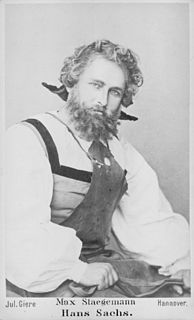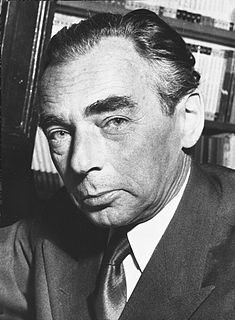Related Research Articles

Die Meistersinger von Nürnberg, WWV 96, is a music drama, or opera, in three acts, by Richard Wagner. It is the longest opera commonly performed, taking nearly four and a half hours, not counting two breaks, and is traditionally not cut. With Hans von Bülow conducting it was first performed on 21 June 1868 at the National Theater in Munich, today home of Bavarian State Opera.

Karl Friedrich May was a German author. He is best known for his 19th century novels of fictitious travels and adventures, set in the American Old West with Winnetou and Old Shatterhand as main protagonists and in the Orient and Middle East with fictional characters Kara Ben Nemsi and Hadschi Halef Omar.

Emil Erich Kästner was a German writer, poet, screenwriter and satirist, known primarily for his humorous, socially astute poems and for children's books including Emil and the Detectives. He received the international Hans Christian Andersen Medal in 1960 for his autobiography Als ich ein kleiner Junge war. He was nominated for the Nobel Prize in Literature in six separate years.
This article contains information about the literary events and publications of 1550.

Nelly Sachs was a German-Swedish poet and playwright. Her experiences resulting from the rise of the Nazis in World War II Europe transformed her into a poignant spokesperson for the grief and yearnings of her fellow Jews. Her best-known play is Eli: Ein Mysterienspiel vom Leiden Israels (1950); other works include the poems "Zeichen im Sand" (1962), "Verzauberung" (1970), and the collections of poetry In den Wohnungen des Todes (1947), Flucht und Verwandlung (1959), Fahrt ins Staublose (1961), and Suche nach Lebenden (1971). She was awarded the 1966 Nobel Prize in Literature.

Hans Sachs was a German Meistersinger ("mastersinger"), poet, playwright, and shoemaker.
Hans Fischerkoesen, also known as Hans Fischerkösen or Hans Fischer, was a German commercial animator. Fischerkoesen is considered an animation pioneer, due to the inventions and innovations he applied to animation technology, especially the use of three-dimensional elements in his animations. Later he becomes Germany's most influential cartoonist, often nicknamed “Germany’s Walt Disney” alongside Rolf Kauka. He won both first and second prizes at a Dutch-sponsored international competition in 1937, for advertising films. By 1956 he had won major prizes at commercial film festivals in Rome, Milan, Venice, Monte Carlo and Cannes. Most notable was the participation in the 1st Berlin International Film Festival, where Fischerkoesen's film Blick ins Paradies won the Bronze Medal award.

Wilhelm Hauff was a Württembergian poet and novelist.

Götz George was a German actor, the son of actor couple Berta Drews and Heinrich George. His arguably best-known role is that of Duisburg detective Horst Schimanski in the TV crime series Tatort.

Carl Zuckmayer was a German writer and playwright. His older brother was the pedagogue, composer, conductor, and pianist Eduard Zuckmayer.

Theo Adam was a German operatic bass-baritone and bass singer who had an international career in opera, concert and recital from 1949. He was a member of the Staatsoper Dresden for his entire career, and sang at the Bayreuth Festival from 1952 to 1980. He particularly excelled in portraying roles by Richard Wagner, especially Wotan in Der Ring des Nibelungen, which he also performed at the Metropolitan Opera, among others. In concert, he was a much admired Bach singer and also drew acclaim for his interpretation of the title character of Mendelssohn's Elijah. He was a voice teacher at the Musikhochschule Dresden.

Grimms' Fairy Tales, originally known as the Children's and Household Tales, is a German collection of fairy tales by the Grimm brothers or "Brothers Grimm", Jacob and Wilhelm, first published on 20 December 1812. This first edition contained 86 stories, and by the seventh edition in 1857, it had 210 unique fairy tales. It is listed by UNESCO in its Memory of the World Registry.

Ernst Wiechert was a German teacher, poet and writer.
In historical Germanic society, nīþ ; was a term for a social stigma implying the loss of honour and the status of a villain. A person affected with the stigma is a nīðing . Middle English retained a cognate nithe, meaning "envy", "hate", or "malice."
Knittelvers is a kind of Germanic verse meter which originated in Germany during the Middle Ages. In Knittelvers, consecutive lines rhyme pairwise (AABB) and each line has four stresses. "Strict" Knittelvers has eight or nine syllables on each line, whereas "free" Knittelvers can use more or fewer. It may be considered a form of doggerel and is sometimes called "Knüttelvers" because of its rhythm. In German, this form of poetry was popular during the 15th and 16th centuries but rejected in the 17th before being brought back into use by Johann Christoph Gottsched in the 18th century.

Juno and Argus is a 1610 painting by Peter Paul Rubens, depicting Juno and Argus. It is now in the Wallraf-Richartz Museum in Cologne.
Jakob Streit was a Swiss author, teacher and anthroposophist. Besides this he worked as musician and choirmaster as well as conductor and dramaturg
Edmund Goetze was a German literary historian and philologist.

Paul Bender was a German operatic bass.
Frank Petzold is a German composer, conductor and jazz pianist. A composer of operas and other stage works, he has worked at theatres, from 1994 as Kapellmeister at the Staatstheater Cottbus. He has lectured music theory and jazz piano at the Brandenburgische Technische Universität in Cottbus from 2001.
References
- ↑ Baldick, Chris (2015). Oxford Dictionary of Literary Terms. Oxford: Oxford University Press.
- ↑ Rudwin, Maximilian Josef (1919). The Origin of the German Carnival Comedy. Leipzig.
- ↑ . Encyclopædia Britannica . Vol. 23 (11th ed.). 1911. p. 972.